Sport Performance Research Report: Elite Sport Policy Analysis
VerifiedAdded on 2020/06/04
|16
|4300
|83
Report
AI Summary
This report provides a comprehensive analysis of elite sport policy from a global perspective, with a specific focus on Australia's Winning Edge Strategy. It examines the relevance of elite sport policy, providing an overview of the strategy's key priorities, including investment, planning, support, gover...

Sport performance
research report
1
research report
1
Paraphrase This Document
Need a fresh take? Get an instant paraphrase of this document with our AI Paraphraser
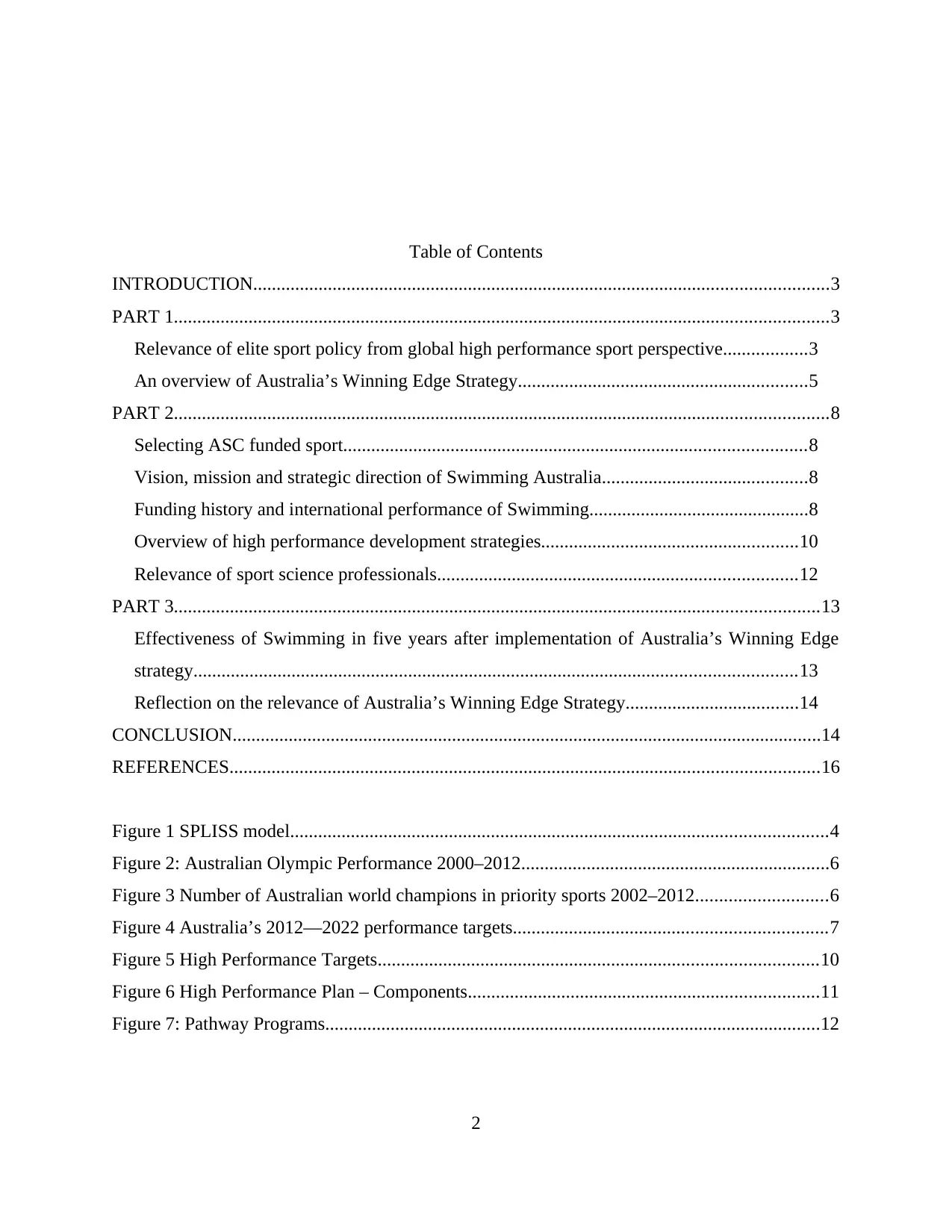
Table of Contents
INTRODUCTION...........................................................................................................................3
PART 1............................................................................................................................................3
Relevance of elite sport policy from global high performance sport perspective..................3
An overview of Australia’s Winning Edge Strategy..............................................................5
PART 2............................................................................................................................................8
Selecting ASC funded sport...................................................................................................8
Vision, mission and strategic direction of Swimming Australia............................................8
Funding history and international performance of Swimming...............................................8
Overview of high performance development strategies.......................................................10
Relevance of sport science professionals.............................................................................12
PART 3..........................................................................................................................................13
Effectiveness of Swimming in five years after implementation of Australia’s Winning Edge
strategy.................................................................................................................................13
Reflection on the relevance of Australia’s Winning Edge Strategy.....................................14
CONCLUSION..............................................................................................................................14
REFERENCES..............................................................................................................................16
Figure 1 SPLISS model...................................................................................................................4
Figure 2: Australian Olympic Performance 2000–2012..................................................................6
Figure 3 Number of Australian world champions in priority sports 2002–2012............................6
Figure 4 Australia’s 2012—2022 performance targets...................................................................7
Figure 5 High Performance Targets..............................................................................................10
Figure 6 High Performance Plan – Components...........................................................................11
Figure 7: Pathway Programs..........................................................................................................12
2
INTRODUCTION...........................................................................................................................3
PART 1............................................................................................................................................3
Relevance of elite sport policy from global high performance sport perspective..................3
An overview of Australia’s Winning Edge Strategy..............................................................5
PART 2............................................................................................................................................8
Selecting ASC funded sport...................................................................................................8
Vision, mission and strategic direction of Swimming Australia............................................8
Funding history and international performance of Swimming...............................................8
Overview of high performance development strategies.......................................................10
Relevance of sport science professionals.............................................................................12
PART 3..........................................................................................................................................13
Effectiveness of Swimming in five years after implementation of Australia’s Winning Edge
strategy.................................................................................................................................13
Reflection on the relevance of Australia’s Winning Edge Strategy.....................................14
CONCLUSION..............................................................................................................................14
REFERENCES..............................................................................................................................16
Figure 1 SPLISS model...................................................................................................................4
Figure 2: Australian Olympic Performance 2000–2012..................................................................6
Figure 3 Number of Australian world champions in priority sports 2002–2012............................6
Figure 4 Australia’s 2012—2022 performance targets...................................................................7
Figure 5 High Performance Targets..............................................................................................10
Figure 6 High Performance Plan – Components...........................................................................11
Figure 7: Pathway Programs..........................................................................................................12
2
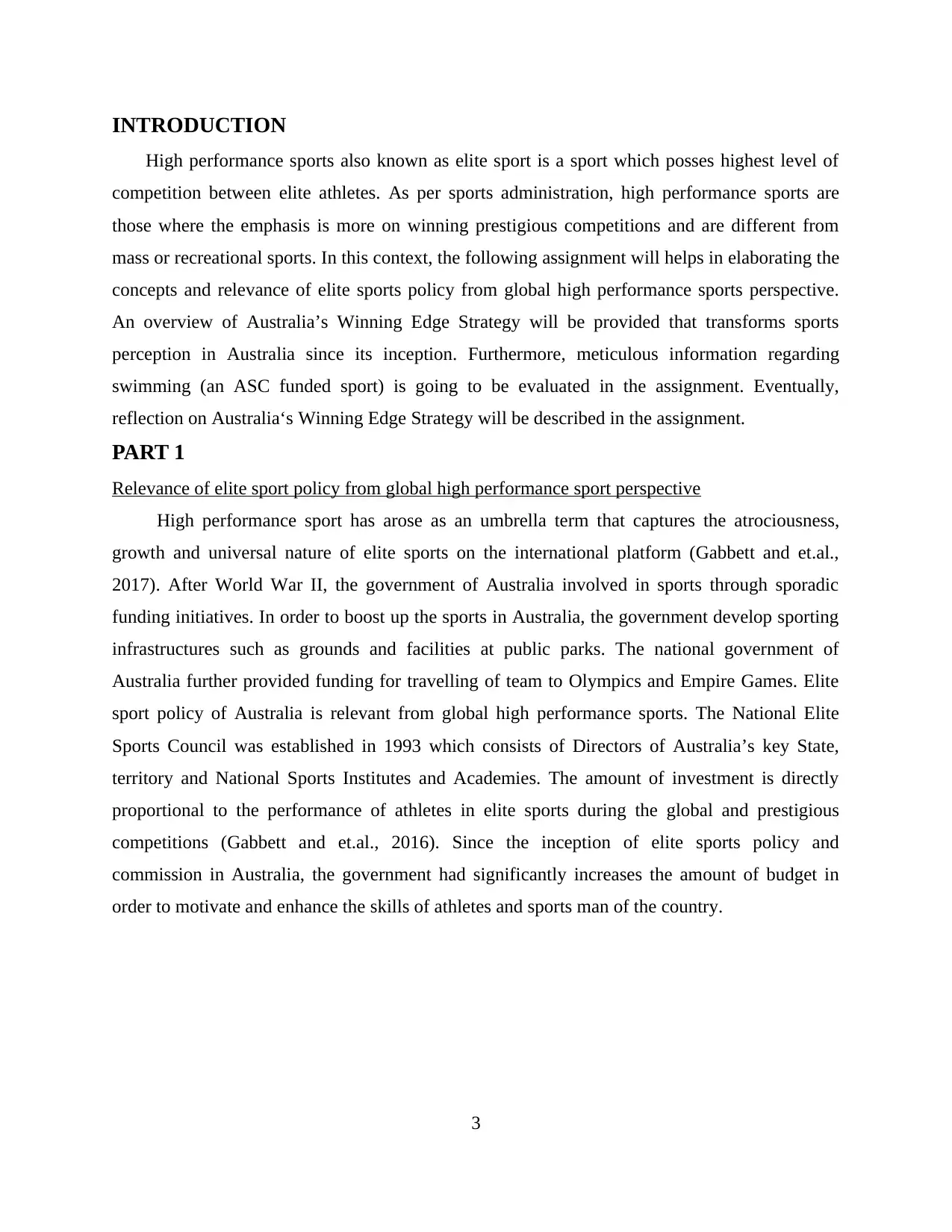
INTRODUCTION
High performance sports also known as elite sport is a sport which posses highest level of
competition between elite athletes. As per sports administration, high performance sports are
those where the emphasis is more on winning prestigious competitions and are different from
mass or recreational sports. In this context, the following assignment will helps in elaborating the
concepts and relevance of elite sports policy from global high performance sports perspective.
An overview of Australia’s Winning Edge Strategy will be provided that transforms sports
perception in Australia since its inception. Furthermore, meticulous information regarding
swimming (an ASC funded sport) is going to be evaluated in the assignment. Eventually,
reflection on Australia‘s Winning Edge Strategy will be described in the assignment.
PART 1
Relevance of elite sport policy from global high performance sport perspective
High performance sport has arose as an umbrella term that captures the atrociousness,
growth and universal nature of elite sports on the international platform (Gabbett and et.al.,
2017). After World War II, the government of Australia involved in sports through sporadic
funding initiatives. In order to boost up the sports in Australia, the government develop sporting
infrastructures such as grounds and facilities at public parks. The national government of
Australia further provided funding for travelling of team to Olympics and Empire Games. Elite
sport policy of Australia is relevant from global high performance sports. The National Elite
Sports Council was established in 1993 which consists of Directors of Australia’s key State,
territory and National Sports Institutes and Academies. The amount of investment is directly
proportional to the performance of athletes in elite sports during the global and prestigious
competitions (Gabbett and et.al., 2016). Since the inception of elite sports policy and
commission in Australia, the government had significantly increases the amount of budget in
order to motivate and enhance the skills of athletes and sports man of the country.
3
High performance sports also known as elite sport is a sport which posses highest level of
competition between elite athletes. As per sports administration, high performance sports are
those where the emphasis is more on winning prestigious competitions and are different from
mass or recreational sports. In this context, the following assignment will helps in elaborating the
concepts and relevance of elite sports policy from global high performance sports perspective.
An overview of Australia’s Winning Edge Strategy will be provided that transforms sports
perception in Australia since its inception. Furthermore, meticulous information regarding
swimming (an ASC funded sport) is going to be evaluated in the assignment. Eventually,
reflection on Australia‘s Winning Edge Strategy will be described in the assignment.
PART 1
Relevance of elite sport policy from global high performance sport perspective
High performance sport has arose as an umbrella term that captures the atrociousness,
growth and universal nature of elite sports on the international platform (Gabbett and et.al.,
2017). After World War II, the government of Australia involved in sports through sporadic
funding initiatives. In order to boost up the sports in Australia, the government develop sporting
infrastructures such as grounds and facilities at public parks. The national government of
Australia further provided funding for travelling of team to Olympics and Empire Games. Elite
sport policy of Australia is relevant from global high performance sports. The National Elite
Sports Council was established in 1993 which consists of Directors of Australia’s key State,
territory and National Sports Institutes and Academies. The amount of investment is directly
proportional to the performance of athletes in elite sports during the global and prestigious
competitions (Gabbett and et.al., 2016). Since the inception of elite sports policy and
commission in Australia, the government had significantly increases the amount of budget in
order to motivate and enhance the skills of athletes and sports man of the country.
3
You're viewing a preview
Unlock full access by subscribing today!
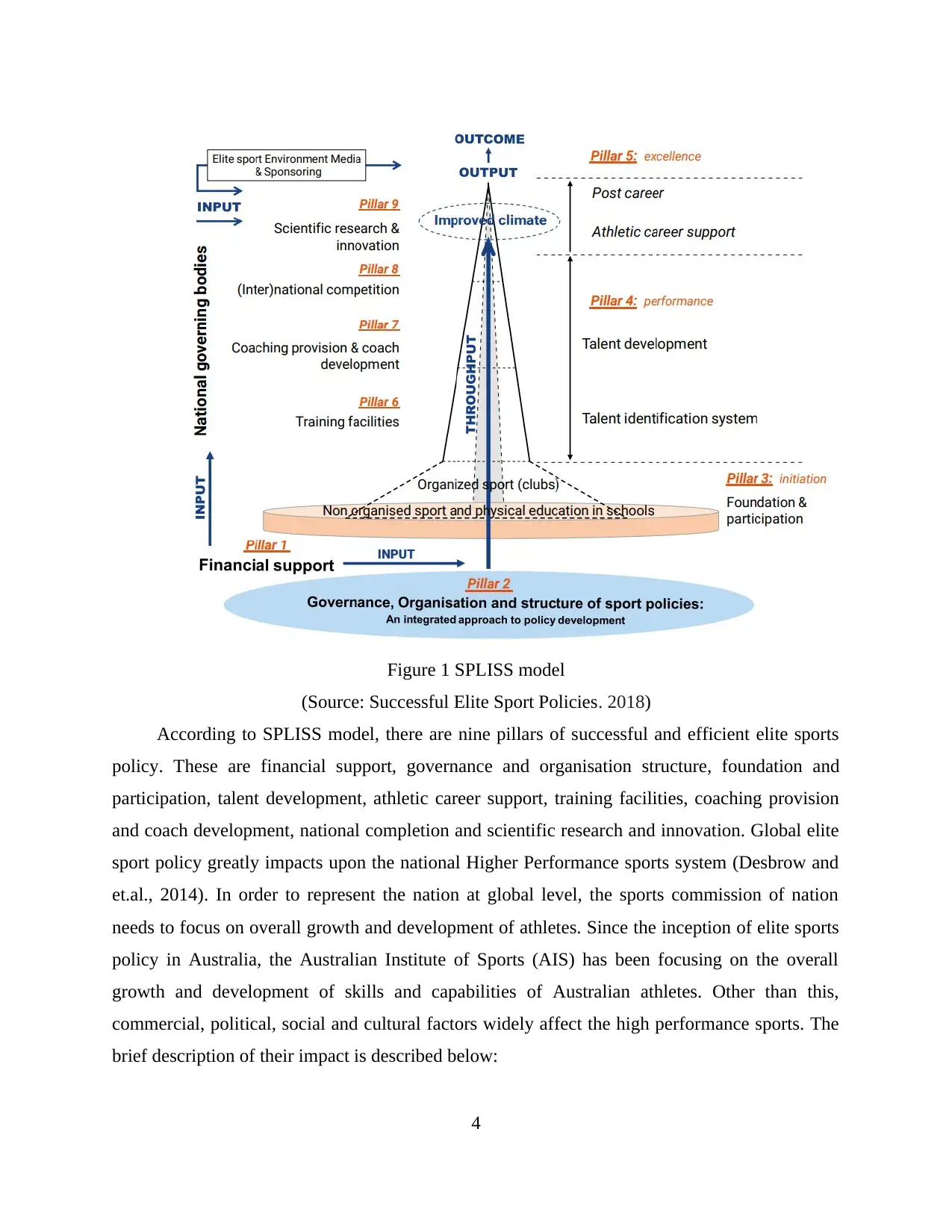
Figure 1 SPLISS model
(Source: Successful Elite Sport Policies. 2018)
According to SPLISS model, there are nine pillars of successful and efficient elite sports
policy. These are financial support, governance and organisation structure, foundation and
participation, talent development, athletic career support, training facilities, coaching provision
and coach development, national completion and scientific research and innovation. Global elite
sport policy greatly impacts upon the national Higher Performance sports system (Desbrow and
et.al., 2014). In order to represent the nation at global level, the sports commission of nation
needs to focus on overall growth and development of athletes. Since the inception of elite sports
policy in Australia, the Australian Institute of Sports (AIS) has been focusing on the overall
growth and development of skills and capabilities of Australian athletes. Other than this,
commercial, political, social and cultural factors widely affect the high performance sports. The
brief description of their impact is described below:
4
(Source: Successful Elite Sport Policies. 2018)
According to SPLISS model, there are nine pillars of successful and efficient elite sports
policy. These are financial support, governance and organisation structure, foundation and
participation, talent development, athletic career support, training facilities, coaching provision
and coach development, national completion and scientific research and innovation. Global elite
sport policy greatly impacts upon the national Higher Performance sports system (Desbrow and
et.al., 2014). In order to represent the nation at global level, the sports commission of nation
needs to focus on overall growth and development of athletes. Since the inception of elite sports
policy in Australia, the Australian Institute of Sports (AIS) has been focusing on the overall
growth and development of skills and capabilities of Australian athletes. Other than this,
commercial, political, social and cultural factors widely affect the high performance sports. The
brief description of their impact is described below:
4
Paraphrase This Document
Need a fresh take? Get an instant paraphrase of this document with our AI Paraphraser
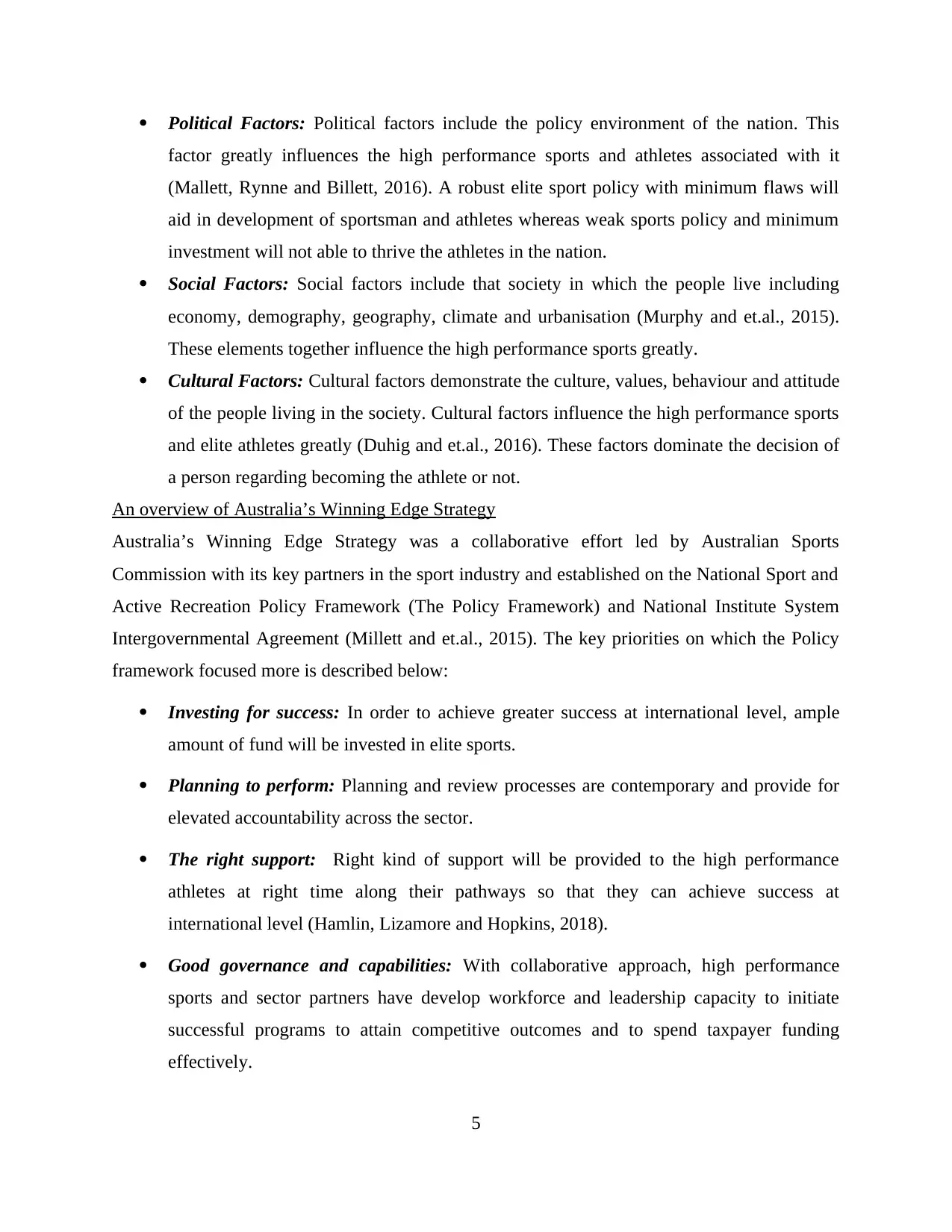
Political Factors: Political factors include the policy environment of the nation. This
factor greatly influences the high performance sports and athletes associated with it
(Mallett, Rynne and Billett, 2016). A robust elite sport policy with minimum flaws will
aid in development of sportsman and athletes whereas weak sports policy and minimum
investment will not able to thrive the athletes in the nation.
Social Factors: Social factors include that society in which the people live including
economy, demography, geography, climate and urbanisation (Murphy and et.al., 2015).
These elements together influence the high performance sports greatly.
Cultural Factors: Cultural factors demonstrate the culture, values, behaviour and attitude
of the people living in the society. Cultural factors influence the high performance sports
and elite athletes greatly (Duhig and et.al., 2016). These factors dominate the decision of
a person regarding becoming the athlete or not.
An overview of Australia’s Winning Edge Strategy
Australia’s Winning Edge Strategy was a collaborative effort led by Australian Sports
Commission with its key partners in the sport industry and established on the National Sport and
Active Recreation Policy Framework (The Policy Framework) and National Institute System
Intergovernmental Agreement (Millett and et.al., 2015). The key priorities on which the Policy
framework focused more is described below:
Investing for success: In order to achieve greater success at international level, ample
amount of fund will be invested in elite sports.
Planning to perform: Planning and review processes are contemporary and provide for
elevated accountability across the sector.
The right support: Right kind of support will be provided to the high performance
athletes at right time along their pathways so that they can achieve success at
international level (Hamlin, Lizamore and Hopkins, 2018).
Good governance and capabilities: With collaborative approach, high performance
sports and sector partners have develop workforce and leadership capacity to initiate
successful programs to attain competitive outcomes and to spend taxpayer funding
effectively.
5
factor greatly influences the high performance sports and athletes associated with it
(Mallett, Rynne and Billett, 2016). A robust elite sport policy with minimum flaws will
aid in development of sportsman and athletes whereas weak sports policy and minimum
investment will not able to thrive the athletes in the nation.
Social Factors: Social factors include that society in which the people live including
economy, demography, geography, climate and urbanisation (Murphy and et.al., 2015).
These elements together influence the high performance sports greatly.
Cultural Factors: Cultural factors demonstrate the culture, values, behaviour and attitude
of the people living in the society. Cultural factors influence the high performance sports
and elite athletes greatly (Duhig and et.al., 2016). These factors dominate the decision of
a person regarding becoming the athlete or not.
An overview of Australia’s Winning Edge Strategy
Australia’s Winning Edge Strategy was a collaborative effort led by Australian Sports
Commission with its key partners in the sport industry and established on the National Sport and
Active Recreation Policy Framework (The Policy Framework) and National Institute System
Intergovernmental Agreement (Millett and et.al., 2015). The key priorities on which the Policy
framework focused more is described below:
Investing for success: In order to achieve greater success at international level, ample
amount of fund will be invested in elite sports.
Planning to perform: Planning and review processes are contemporary and provide for
elevated accountability across the sector.
The right support: Right kind of support will be provided to the high performance
athletes at right time along their pathways so that they can achieve success at
international level (Hamlin, Lizamore and Hopkins, 2018).
Good governance and capabilities: With collaborative approach, high performance
sports and sector partners have develop workforce and leadership capacity to initiate
successful programs to attain competitive outcomes and to spend taxpayer funding
effectively.
5
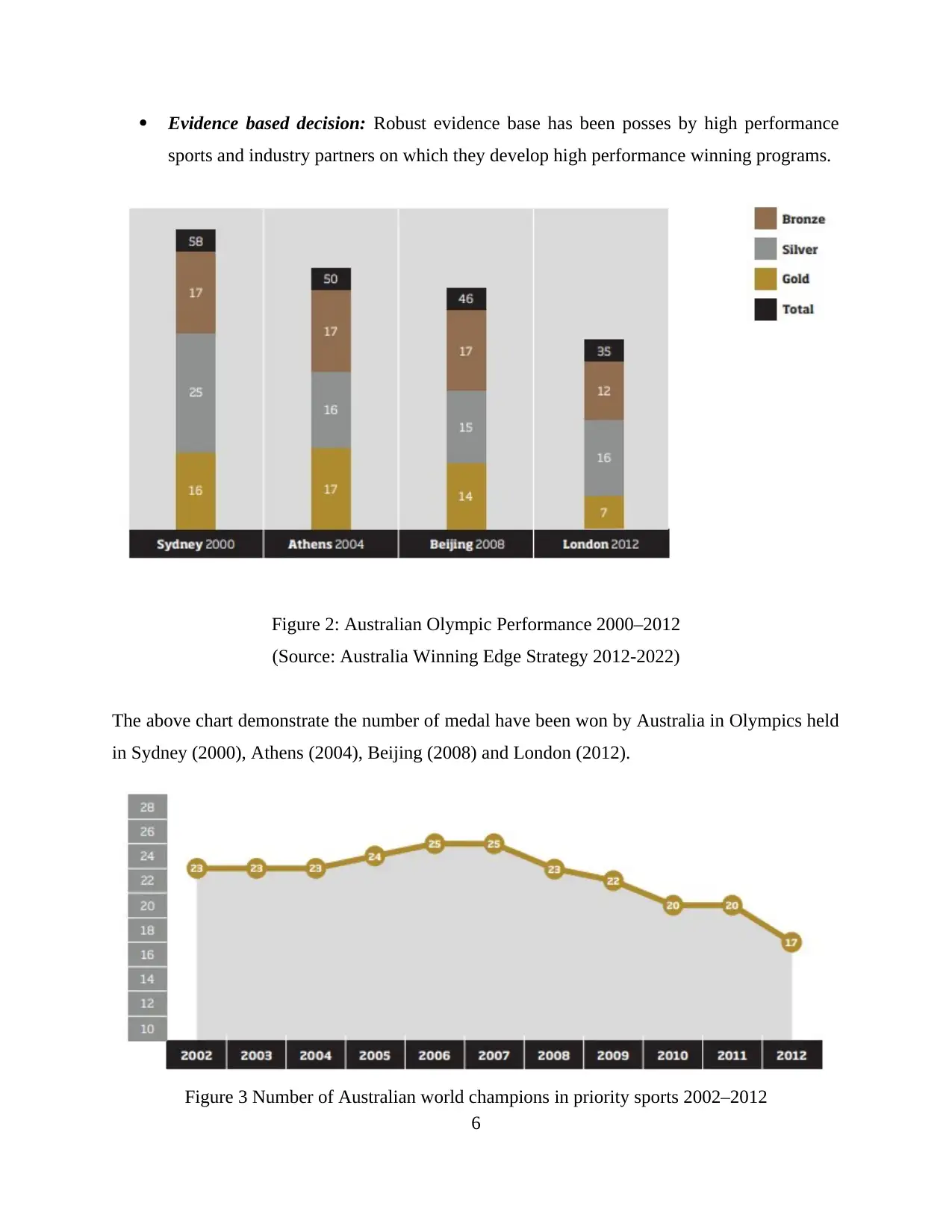
Evidence based decision: Robust evidence base has been posses by high performance
sports and industry partners on which they develop high performance winning programs.
Figure 2: Australian Olympic Performance 2000–2012
(Source: Australia Winning Edge Strategy 2012-2022)
The above chart demonstrate the number of medal have been won by Australia in Olympics held
in Sydney (2000), Athens (2004), Beijing (2008) and London (2012).
Figure 3 Number of Australian world champions in priority sports 2002–2012
6
sports and industry partners on which they develop high performance winning programs.
Figure 2: Australian Olympic Performance 2000–2012
(Source: Australia Winning Edge Strategy 2012-2022)
The above chart demonstrate the number of medal have been won by Australia in Olympics held
in Sydney (2000), Athens (2004), Beijing (2008) and London (2012).
Figure 3 Number of Australian world champions in priority sports 2002–2012
6
You're viewing a preview
Unlock full access by subscribing today!
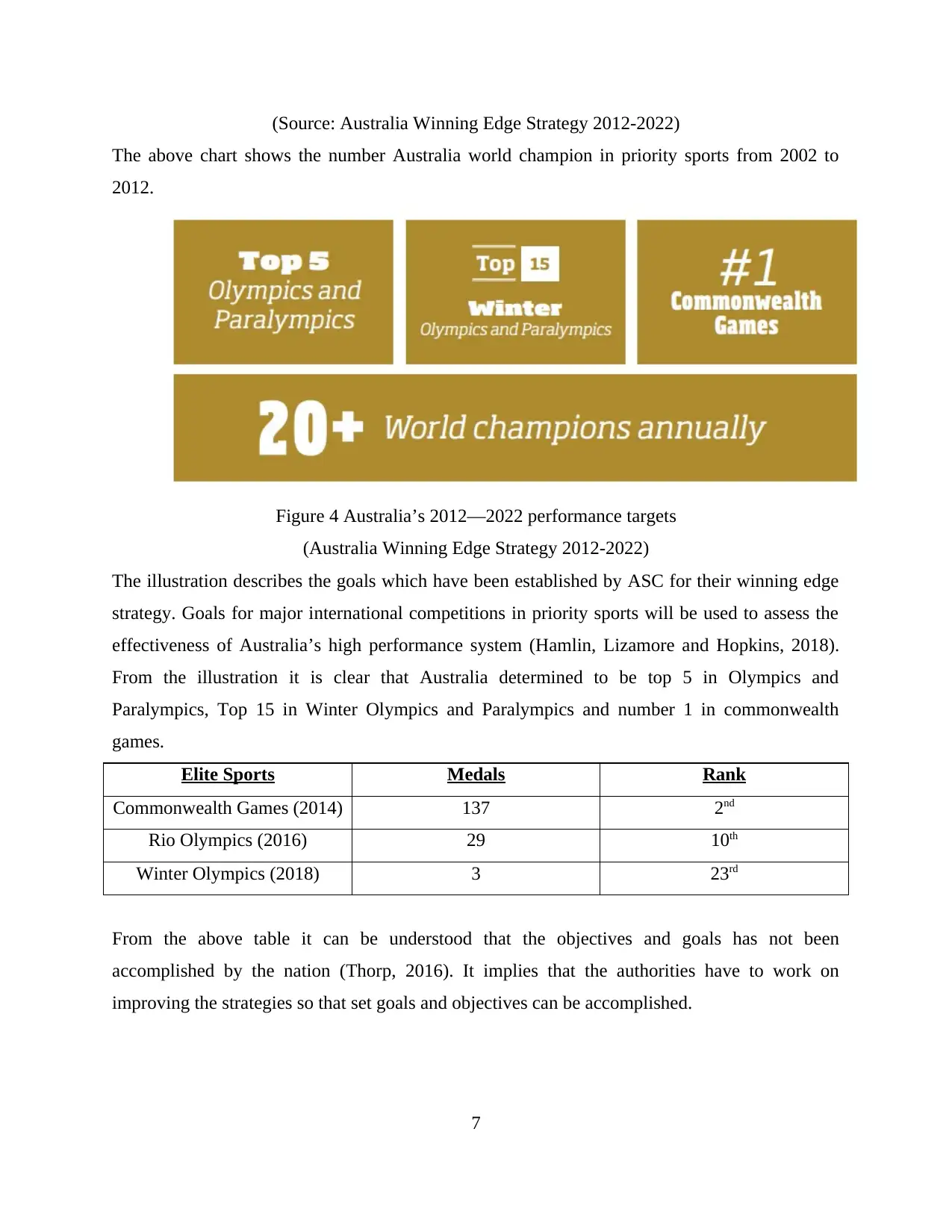
(Source: Australia Winning Edge Strategy 2012-2022)
The above chart shows the number Australia world champion in priority sports from 2002 to
2012.
Figure 4 Australia’s 2012—2022 performance targets
(Australia Winning Edge Strategy 2012-2022)
The illustration describes the goals which have been established by ASC for their winning edge
strategy. Goals for major international competitions in priority sports will be used to assess the
effectiveness of Australia’s high performance system (Hamlin, Lizamore and Hopkins, 2018).
From the illustration it is clear that Australia determined to be top 5 in Olympics and
Paralympics, Top 15 in Winter Olympics and Paralympics and number 1 in commonwealth
games.
Elite Sports Medals Rank
Commonwealth Games (2014) 137 2nd
Rio Olympics (2016) 29 10th
Winter Olympics (2018) 3 23rd
From the above table it can be understood that the objectives and goals has not been
accomplished by the nation (Thorp, 2016). It implies that the authorities have to work on
improving the strategies so that set goals and objectives can be accomplished.
7
The above chart shows the number Australia world champion in priority sports from 2002 to
2012.
Figure 4 Australia’s 2012—2022 performance targets
(Australia Winning Edge Strategy 2012-2022)
The illustration describes the goals which have been established by ASC for their winning edge
strategy. Goals for major international competitions in priority sports will be used to assess the
effectiveness of Australia’s high performance system (Hamlin, Lizamore and Hopkins, 2018).
From the illustration it is clear that Australia determined to be top 5 in Olympics and
Paralympics, Top 15 in Winter Olympics and Paralympics and number 1 in commonwealth
games.
Elite Sports Medals Rank
Commonwealth Games (2014) 137 2nd
Rio Olympics (2016) 29 10th
Winter Olympics (2018) 3 23rd
From the above table it can be understood that the objectives and goals has not been
accomplished by the nation (Thorp, 2016). It implies that the authorities have to work on
improving the strategies so that set goals and objectives can be accomplished.
7
Paraphrase This Document
Need a fresh take? Get an instant paraphrase of this document with our AI Paraphraser

PART 2
Selecting ASC funded sport
Swimming is one of the most high performance sports in Australia. As majority of medals in
Summer Olympics have been won in swimming, it has been chosen for further analysis.
Swimming is considered as Level 1 sport in Australia with very high probability of getting gold
in Olympics and commonwealth games (Brockett, 2017). A Pathway program has been
established by Swimming Australia (SAL) in 2014 in order to develop Australia’s next
generation of swimmers. It is the series of program which is funded by Australian Institute of
Sports and Australian Commission of Sport.
Vision, mission and strategic direction of Swimming Australia
The vision, mission and strategic direction of Swimming Australia is described below:
Vision: The vision of Swimming is to be recognised as world leader in swimming sports. A
vision statement is the first step in the strategic planning process followed closely by the
development of mission statement (Schilsky, 2015). Through this statement, it can be understood
that Swimming Australia with its initiative and developmental programmes desire to become the
leading sporting organisation in the world.
Mission: Mission statement briefly describes the purpose of the Swimming Australia. The
mission statement of Swimming Australia is “To develop and deliver effective services and
support to our stakeholders”. From this mission statement it can be understood that the
management of Swimming Australia deliver excellent services and supports to entities who are
directly and indirectly associated with it.
Strategic Direction: Through new Pathway program, the management aims to enhance the
capabilities and skills of Australia’s next generation swimmers so that they can represent their
nation at national and international level effectively and efficiently (Gabbett and et.al., 2017).
Funding history and international performance of Swimming
Swimming comes under Level F1 category high performance sport which is funded
enormously by Australian Sports Commission. As there is high probability of winning gold in
swimming, the authorities prefer to invest it in more so that growth and development of
swimmers can be made (Gabbett and et.al., 2016).
Below is the table that describes the funding history of Swimming in Australia:
High performance sports Funding (2012-2016) Funding 2017
8
Selecting ASC funded sport
Swimming is one of the most high performance sports in Australia. As majority of medals in
Summer Olympics have been won in swimming, it has been chosen for further analysis.
Swimming is considered as Level 1 sport in Australia with very high probability of getting gold
in Olympics and commonwealth games (Brockett, 2017). A Pathway program has been
established by Swimming Australia (SAL) in 2014 in order to develop Australia’s next
generation of swimmers. It is the series of program which is funded by Australian Institute of
Sports and Australian Commission of Sport.
Vision, mission and strategic direction of Swimming Australia
The vision, mission and strategic direction of Swimming Australia is described below:
Vision: The vision of Swimming is to be recognised as world leader in swimming sports. A
vision statement is the first step in the strategic planning process followed closely by the
development of mission statement (Schilsky, 2015). Through this statement, it can be understood
that Swimming Australia with its initiative and developmental programmes desire to become the
leading sporting organisation in the world.
Mission: Mission statement briefly describes the purpose of the Swimming Australia. The
mission statement of Swimming Australia is “To develop and deliver effective services and
support to our stakeholders”. From this mission statement it can be understood that the
management of Swimming Australia deliver excellent services and supports to entities who are
directly and indirectly associated with it.
Strategic Direction: Through new Pathway program, the management aims to enhance the
capabilities and skills of Australia’s next generation swimmers so that they can represent their
nation at national and international level effectively and efficiently (Gabbett and et.al., 2017).
Funding history and international performance of Swimming
Swimming comes under Level F1 category high performance sport which is funded
enormously by Australian Sports Commission. As there is high probability of winning gold in
swimming, the authorities prefer to invest it in more so that growth and development of
swimmers can be made (Gabbett and et.al., 2016).
Below is the table that describes the funding history of Swimming in Australia:
High performance sports Funding (2012-2016) Funding 2017
8
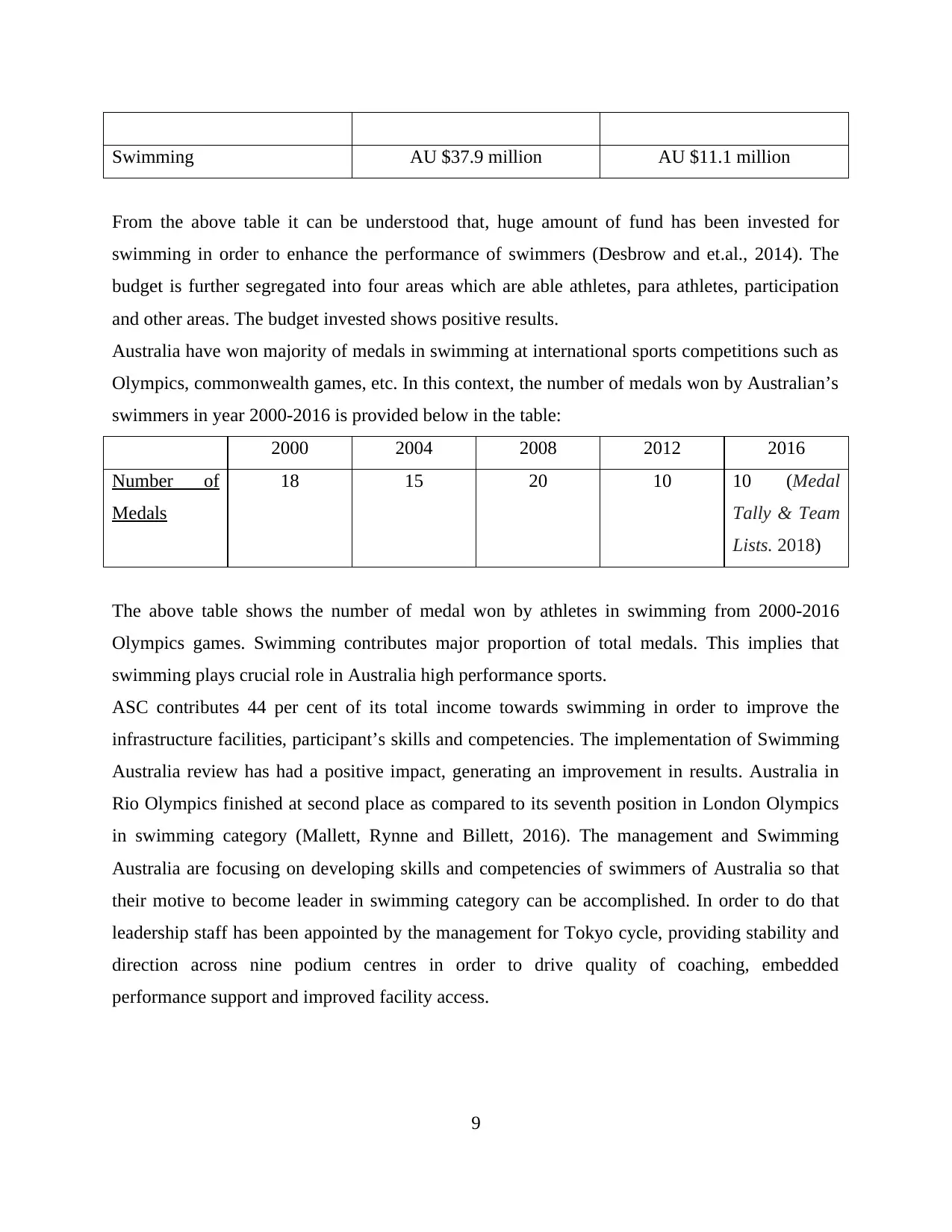
Swimming AU $37.9 million AU $11.1 million
From the above table it can be understood that, huge amount of fund has been invested for
swimming in order to enhance the performance of swimmers (Desbrow and et.al., 2014). The
budget is further segregated into four areas which are able athletes, para athletes, participation
and other areas. The budget invested shows positive results.
Australia have won majority of medals in swimming at international sports competitions such as
Olympics, commonwealth games, etc. In this context, the number of medals won by Australian’s
swimmers in year 2000-2016 is provided below in the table:
2000 2004 2008 2012 2016
Number of
Medals
18 15 20 10 10 (Medal
Tally & Team
Lists. 2018)
The above table shows the number of medal won by athletes in swimming from 2000-2016
Olympics games. Swimming contributes major proportion of total medals. This implies that
swimming plays crucial role in Australia high performance sports.
ASC contributes 44 per cent of its total income towards swimming in order to improve the
infrastructure facilities, participant’s skills and competencies. The implementation of Swimming
Australia review has had a positive impact, generating an improvement in results. Australia in
Rio Olympics finished at second place as compared to its seventh position in London Olympics
in swimming category (Mallett, Rynne and Billett, 2016). The management and Swimming
Australia are focusing on developing skills and competencies of swimmers of Australia so that
their motive to become leader in swimming category can be accomplished. In order to do that
leadership staff has been appointed by the management for Tokyo cycle, providing stability and
direction across nine podium centres in order to drive quality of coaching, embedded
performance support and improved facility access.
9
From the above table it can be understood that, huge amount of fund has been invested for
swimming in order to enhance the performance of swimmers (Desbrow and et.al., 2014). The
budget is further segregated into four areas which are able athletes, para athletes, participation
and other areas. The budget invested shows positive results.
Australia have won majority of medals in swimming at international sports competitions such as
Olympics, commonwealth games, etc. In this context, the number of medals won by Australian’s
swimmers in year 2000-2016 is provided below in the table:
2000 2004 2008 2012 2016
Number of
Medals
18 15 20 10 10 (Medal
Tally & Team
Lists. 2018)
The above table shows the number of medal won by athletes in swimming from 2000-2016
Olympics games. Swimming contributes major proportion of total medals. This implies that
swimming plays crucial role in Australia high performance sports.
ASC contributes 44 per cent of its total income towards swimming in order to improve the
infrastructure facilities, participant’s skills and competencies. The implementation of Swimming
Australia review has had a positive impact, generating an improvement in results. Australia in
Rio Olympics finished at second place as compared to its seventh position in London Olympics
in swimming category (Mallett, Rynne and Billett, 2016). The management and Swimming
Australia are focusing on developing skills and competencies of swimmers of Australia so that
their motive to become leader in swimming category can be accomplished. In order to do that
leadership staff has been appointed by the management for Tokyo cycle, providing stability and
direction across nine podium centres in order to drive quality of coaching, embedded
performance support and improved facility access.
9
You're viewing a preview
Unlock full access by subscribing today!
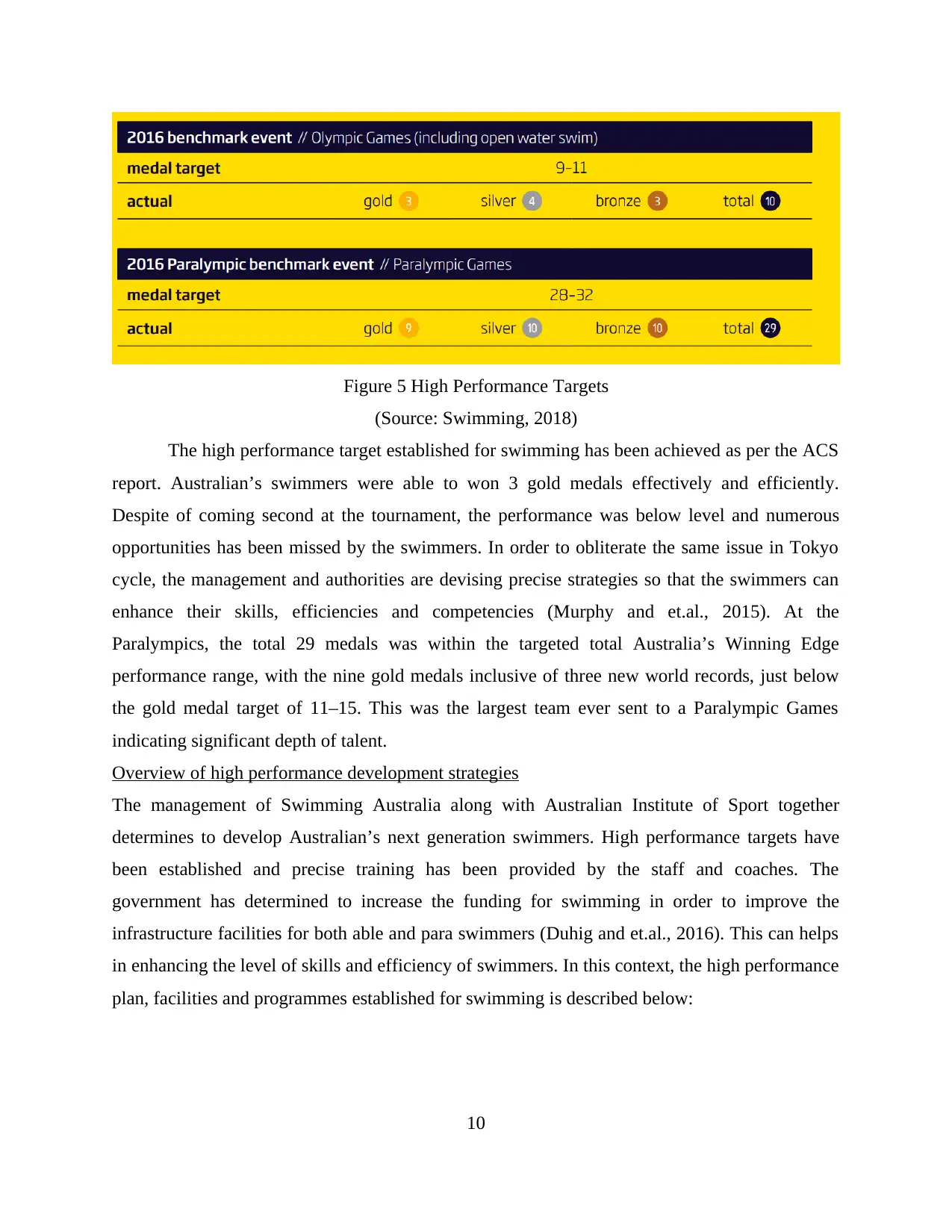
Figure 5 High Performance Targets
(Source: Swimming, 2018)
The high performance target established for swimming has been achieved as per the ACS
report. Australian’s swimmers were able to won 3 gold medals effectively and efficiently.
Despite of coming second at the tournament, the performance was below level and numerous
opportunities has been missed by the swimmers. In order to obliterate the same issue in Tokyo
cycle, the management and authorities are devising precise strategies so that the swimmers can
enhance their skills, efficiencies and competencies (Murphy and et.al., 2015). At the
Paralympics, the total 29 medals was within the targeted total Australia’s Winning Edge
performance range, with the nine gold medals inclusive of three new world records, just below
the gold medal target of 11–15. This was the largest team ever sent to a Paralympic Games
indicating significant depth of talent.
Overview of high performance development strategies
The management of Swimming Australia along with Australian Institute of Sport together
determines to develop Australian’s next generation swimmers. High performance targets have
been established and precise training has been provided by the staff and coaches. The
government has determined to increase the funding for swimming in order to improve the
infrastructure facilities for both able and para swimmers (Duhig and et.al., 2016). This can helps
in enhancing the level of skills and efficiency of swimmers. In this context, the high performance
plan, facilities and programmes established for swimming is described below:
10
(Source: Swimming, 2018)
The high performance target established for swimming has been achieved as per the ACS
report. Australian’s swimmers were able to won 3 gold medals effectively and efficiently.
Despite of coming second at the tournament, the performance was below level and numerous
opportunities has been missed by the swimmers. In order to obliterate the same issue in Tokyo
cycle, the management and authorities are devising precise strategies so that the swimmers can
enhance their skills, efficiencies and competencies (Murphy and et.al., 2015). At the
Paralympics, the total 29 medals was within the targeted total Australia’s Winning Edge
performance range, with the nine gold medals inclusive of three new world records, just below
the gold medal target of 11–15. This was the largest team ever sent to a Paralympic Games
indicating significant depth of talent.
Overview of high performance development strategies
The management of Swimming Australia along with Australian Institute of Sport together
determines to develop Australian’s next generation swimmers. High performance targets have
been established and precise training has been provided by the staff and coaches. The
government has determined to increase the funding for swimming in order to improve the
infrastructure facilities for both able and para swimmers (Duhig and et.al., 2016). This can helps
in enhancing the level of skills and efficiency of swimmers. In this context, the high performance
plan, facilities and programmes established for swimming is described below:
10
Paraphrase This Document
Need a fresh take? Get an instant paraphrase of this document with our AI Paraphraser
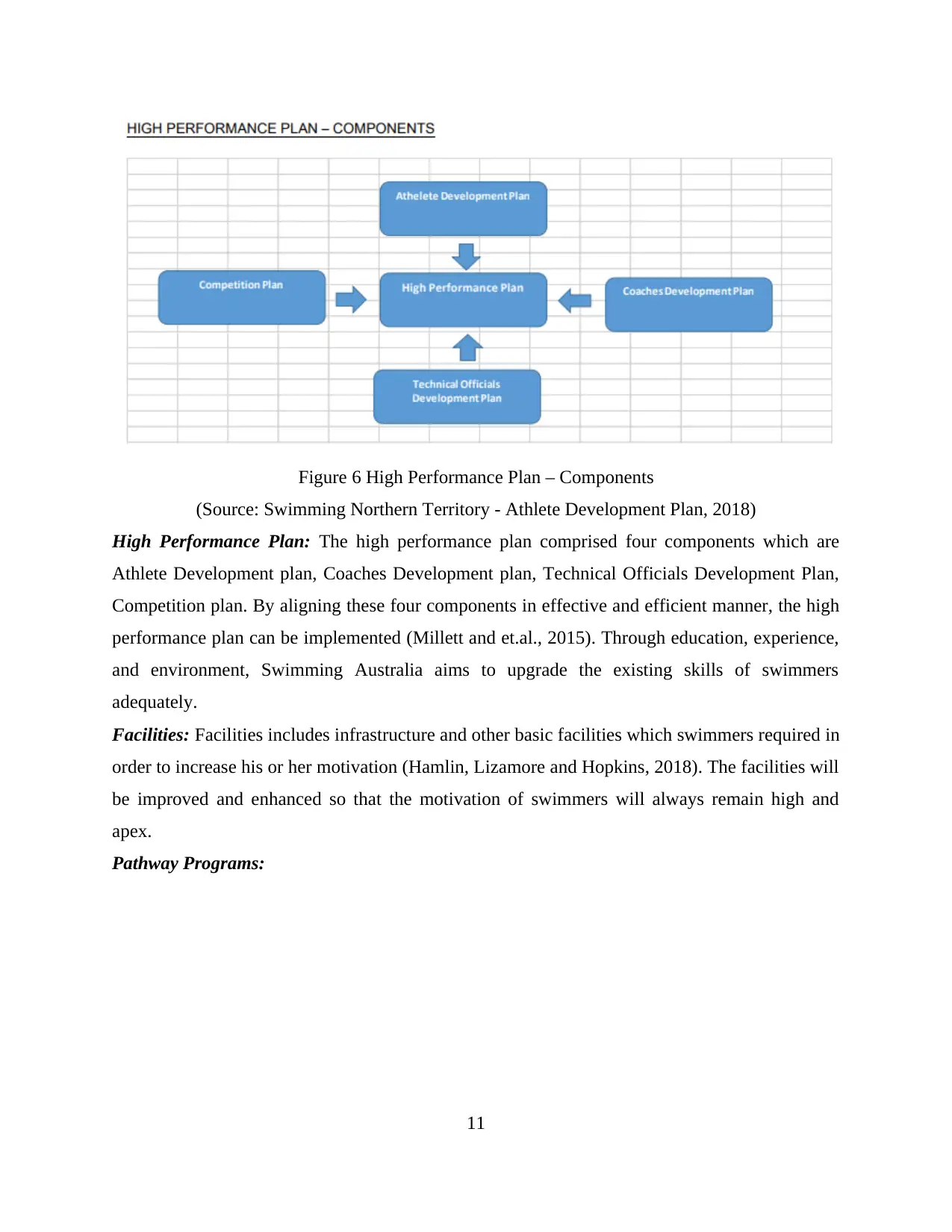
Figure 6 High Performance Plan – Components
(Source: Swimming Northern Territory - Athlete Development Plan, 2018)
High Performance Plan: The high performance plan comprised four components which are
Athlete Development plan, Coaches Development plan, Technical Officials Development Plan,
Competition plan. By aligning these four components in effective and efficient manner, the high
performance plan can be implemented (Millett and et.al., 2015). Through education, experience,
and environment, Swimming Australia aims to upgrade the existing skills of swimmers
adequately.
Facilities: Facilities includes infrastructure and other basic facilities which swimmers required in
order to increase his or her motivation (Hamlin, Lizamore and Hopkins, 2018). The facilities will
be improved and enhanced so that the motivation of swimmers will always remain high and
apex.
Pathway Programs:
11
(Source: Swimming Northern Territory - Athlete Development Plan, 2018)
High Performance Plan: The high performance plan comprised four components which are
Athlete Development plan, Coaches Development plan, Technical Officials Development Plan,
Competition plan. By aligning these four components in effective and efficient manner, the high
performance plan can be implemented (Millett and et.al., 2015). Through education, experience,
and environment, Swimming Australia aims to upgrade the existing skills of swimmers
adequately.
Facilities: Facilities includes infrastructure and other basic facilities which swimmers required in
order to increase his or her motivation (Hamlin, Lizamore and Hopkins, 2018). The facilities will
be improved and enhanced so that the motivation of swimmers will always remain high and
apex.
Pathway Programs:
11
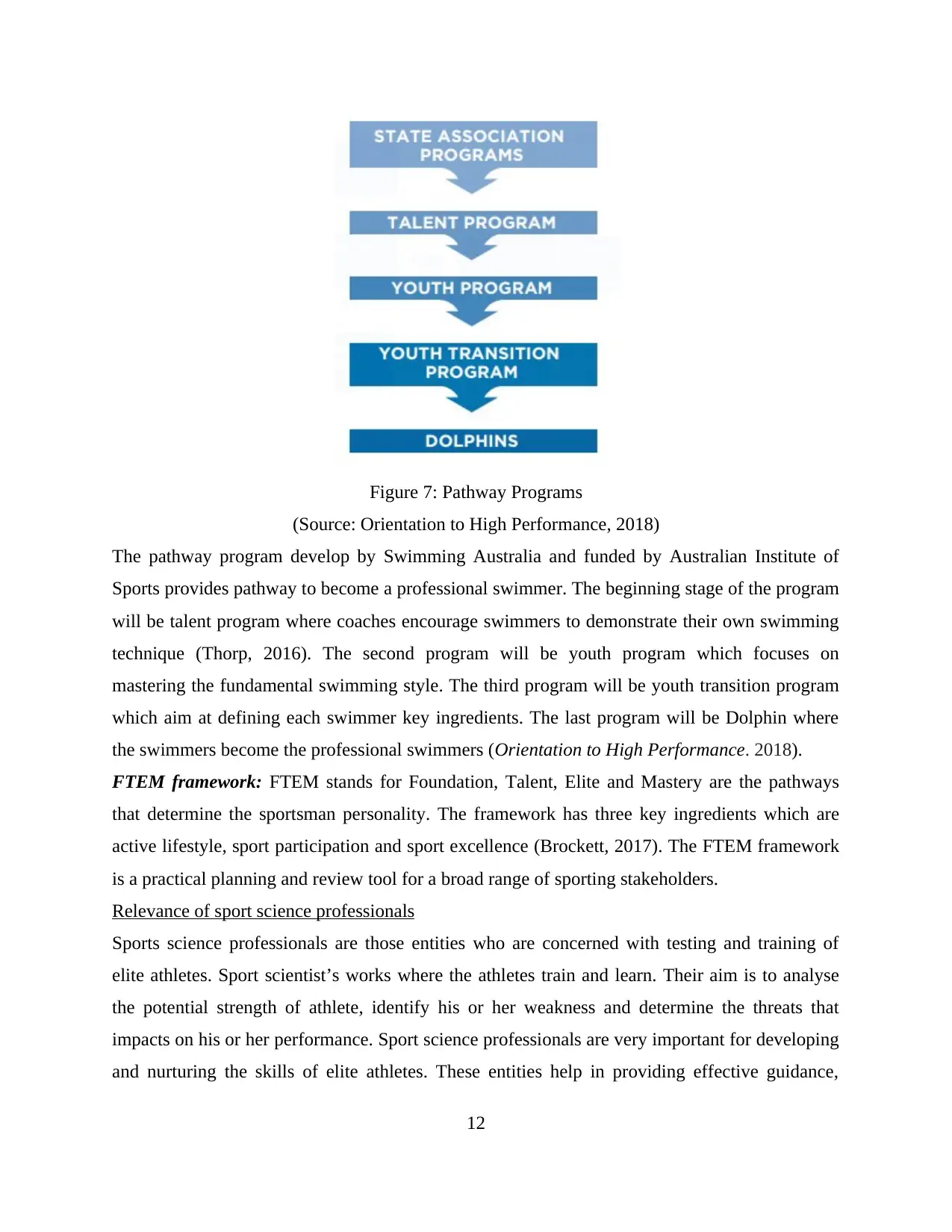
Figure 7: Pathway Programs
(Source: Orientation to High Performance, 2018)
The pathway program develop by Swimming Australia and funded by Australian Institute of
Sports provides pathway to become a professional swimmer. The beginning stage of the program
will be talent program where coaches encourage swimmers to demonstrate their own swimming
technique (Thorp, 2016). The second program will be youth program which focuses on
mastering the fundamental swimming style. The third program will be youth transition program
which aim at defining each swimmer key ingredients. The last program will be Dolphin where
the swimmers become the professional swimmers (Orientation to High Performance. 2018).
FTEM framework: FTEM stands for Foundation, Talent, Elite and Mastery are the pathways
that determine the sportsman personality. The framework has three key ingredients which are
active lifestyle, sport participation and sport excellence (Brockett, 2017). The FTEM framework
is a practical planning and review tool for a broad range of sporting stakeholders.
Relevance of sport science professionals
Sports science professionals are those entities who are concerned with testing and training of
elite athletes. Sport scientist’s works where the athletes train and learn. Their aim is to analyse
the potential strength of athlete, identify his or her weakness and determine the threats that
impacts on his or her performance. Sport science professionals are very important for developing
and nurturing the skills of elite athletes. These entities help in providing effective guidance,
12
(Source: Orientation to High Performance, 2018)
The pathway program develop by Swimming Australia and funded by Australian Institute of
Sports provides pathway to become a professional swimmer. The beginning stage of the program
will be talent program where coaches encourage swimmers to demonstrate their own swimming
technique (Thorp, 2016). The second program will be youth program which focuses on
mastering the fundamental swimming style. The third program will be youth transition program
which aim at defining each swimmer key ingredients. The last program will be Dolphin where
the swimmers become the professional swimmers (Orientation to High Performance. 2018).
FTEM framework: FTEM stands for Foundation, Talent, Elite and Mastery are the pathways
that determine the sportsman personality. The framework has three key ingredients which are
active lifestyle, sport participation and sport excellence (Brockett, 2017). The FTEM framework
is a practical planning and review tool for a broad range of sporting stakeholders.
Relevance of sport science professionals
Sports science professionals are those entities who are concerned with testing and training of
elite athletes. Sport scientist’s works where the athletes train and learn. Their aim is to analyse
the potential strength of athlete, identify his or her weakness and determine the threats that
impacts on his or her performance. Sport science professionals are very important for developing
and nurturing the skills of elite athletes. These entities help in providing effective guidance,
12
You're viewing a preview
Unlock full access by subscribing today!
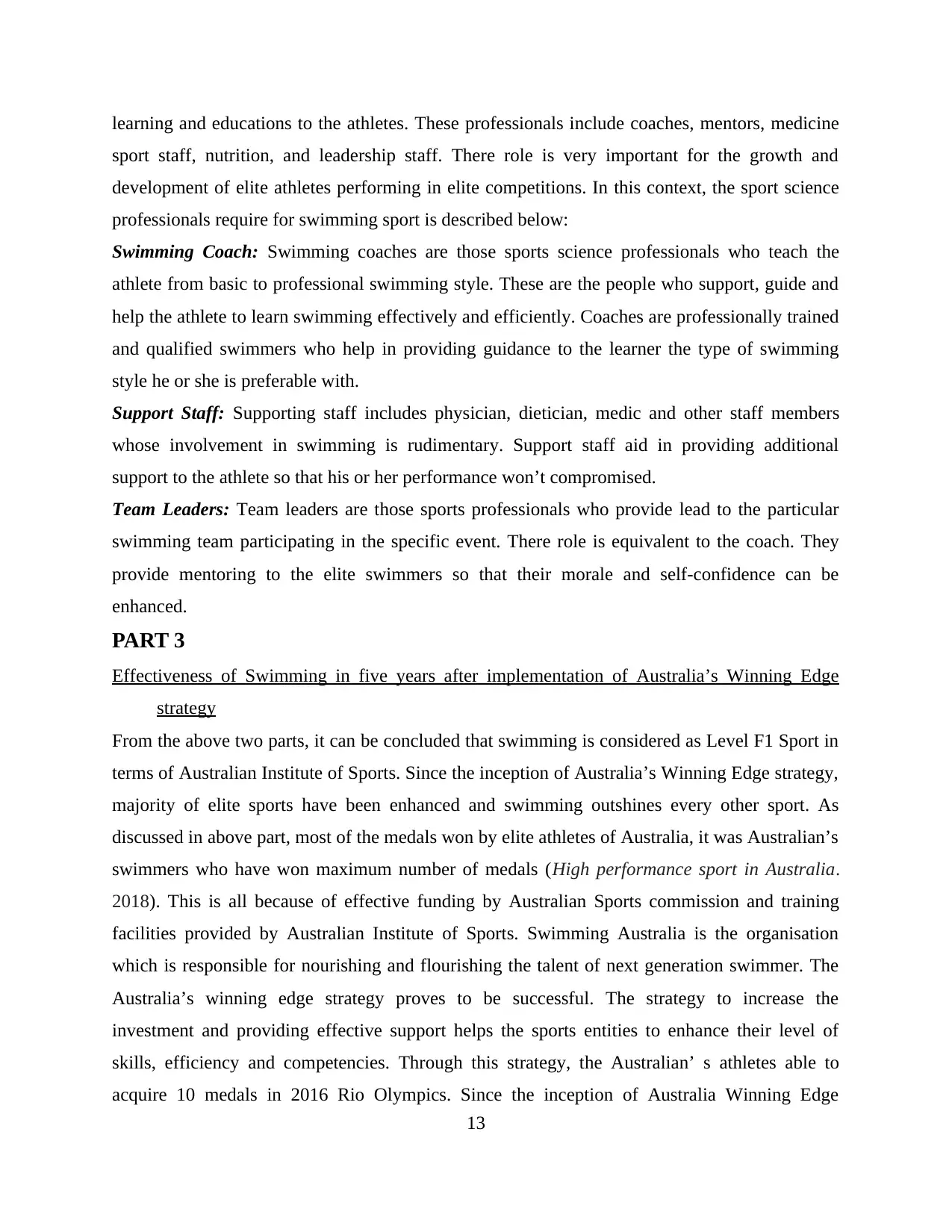
learning and educations to the athletes. These professionals include coaches, mentors, medicine
sport staff, nutrition, and leadership staff. There role is very important for the growth and
development of elite athletes performing in elite competitions. In this context, the sport science
professionals require for swimming sport is described below:
Swimming Coach: Swimming coaches are those sports science professionals who teach the
athlete from basic to professional swimming style. These are the people who support, guide and
help the athlete to learn swimming effectively and efficiently. Coaches are professionally trained
and qualified swimmers who help in providing guidance to the learner the type of swimming
style he or she is preferable with.
Support Staff: Supporting staff includes physician, dietician, medic and other staff members
whose involvement in swimming is rudimentary. Support staff aid in providing additional
support to the athlete so that his or her performance won’t compromised.
Team Leaders: Team leaders are those sports professionals who provide lead to the particular
swimming team participating in the specific event. There role is equivalent to the coach. They
provide mentoring to the elite swimmers so that their morale and self-confidence can be
enhanced.
PART 3
Effectiveness of Swimming in five years after implementation of Australia’s Winning Edge
strategy
From the above two parts, it can be concluded that swimming is considered as Level F1 Sport in
terms of Australian Institute of Sports. Since the inception of Australia’s Winning Edge strategy,
majority of elite sports have been enhanced and swimming outshines every other sport. As
discussed in above part, most of the medals won by elite athletes of Australia, it was Australian’s
swimmers who have won maximum number of medals (High performance sport in Australia.
2018). This is all because of effective funding by Australian Sports commission and training
facilities provided by Australian Institute of Sports. Swimming Australia is the organisation
which is responsible for nourishing and flourishing the talent of next generation swimmer. The
Australia’s winning edge strategy proves to be successful. The strategy to increase the
investment and providing effective support helps the sports entities to enhance their level of
skills, efficiency and competencies. Through this strategy, the Australian’ s athletes able to
acquire 10 medals in 2016 Rio Olympics. Since the inception of Australia Winning Edge
13
sport staff, nutrition, and leadership staff. There role is very important for the growth and
development of elite athletes performing in elite competitions. In this context, the sport science
professionals require for swimming sport is described below:
Swimming Coach: Swimming coaches are those sports science professionals who teach the
athlete from basic to professional swimming style. These are the people who support, guide and
help the athlete to learn swimming effectively and efficiently. Coaches are professionally trained
and qualified swimmers who help in providing guidance to the learner the type of swimming
style he or she is preferable with.
Support Staff: Supporting staff includes physician, dietician, medic and other staff members
whose involvement in swimming is rudimentary. Support staff aid in providing additional
support to the athlete so that his or her performance won’t compromised.
Team Leaders: Team leaders are those sports professionals who provide lead to the particular
swimming team participating in the specific event. There role is equivalent to the coach. They
provide mentoring to the elite swimmers so that their morale and self-confidence can be
enhanced.
PART 3
Effectiveness of Swimming in five years after implementation of Australia’s Winning Edge
strategy
From the above two parts, it can be concluded that swimming is considered as Level F1 Sport in
terms of Australian Institute of Sports. Since the inception of Australia’s Winning Edge strategy,
majority of elite sports have been enhanced and swimming outshines every other sport. As
discussed in above part, most of the medals won by elite athletes of Australia, it was Australian’s
swimmers who have won maximum number of medals (High performance sport in Australia.
2018). This is all because of effective funding by Australian Sports commission and training
facilities provided by Australian Institute of Sports. Swimming Australia is the organisation
which is responsible for nourishing and flourishing the talent of next generation swimmer. The
Australia’s winning edge strategy proves to be successful. The strategy to increase the
investment and providing effective support helps the sports entities to enhance their level of
skills, efficiency and competencies. Through this strategy, the Australian’ s athletes able to
acquire 10 medals in 2016 Rio Olympics. Since the inception of Australia Winning Edge
13
Paraphrase This Document
Need a fresh take? Get an instant paraphrase of this document with our AI Paraphraser

Strategy, the athletes were able to enhance their level of skills and competencies. With effective
infrastructure, efficient support and proper guidance, the elite athletes of Australia were able to
improve their skills and efficiencies effectively and efficiently. With high performance plan,
coaching and guidance, elite athletes of Australia were able educate themselves adequately. In
this context, it can be concluded that Australia’s Winning Edge Strategy was successful and
efficient in nurturing the skills, efficiencies, confidence, motivation and knowledge of
swimmers.
Reflection on the relevance of Australia’s Winning Edge Strategy
Australia’s Winning Edge strategy was launched in 2012 in order to improve the high
performance sports in Australia (High Performance Strategy. 2018). The strategy aim to develop
the elite sports and athletes in a manner so that the nation becomes number one in every elite
sports. The winning strategy focused on five key priorities areas in order to enhance the elite
sports performance. These areas are investment, planning, support, governance and decisions.
The winning edge strategy proves to be successful since its implementation and brought too
many medals for the country. Though, there were many other elite sports in which the strategy
fails to deliver the expectations. Many teams didn’t performs well in Rio Olympics 2016.
Swimming, sailing, rowing was some of the elite sports in which major proportion of amount
funded but the athletes fails to stand upon the expectations. The strategy aims to position the
nation rank in top 5 in medal list but in 2016 Rio Olympics, Australia ranks 10th with 29 medals.
In this context, The Australian Sports Commission and Australian Institute of Sports proposed a
decision for not using Winning Edge Strategy from December 2017 (Jeffery, 2017).
CONCLUSION
From the above report, it can be concluded that high performance sports also known as elite
sport is a sport which posses highest level of competition between elite athletes. In this context,
the relevance of elite sport policy from global high performance sport perspective has been
discussed in the assignment. An overview of Australia’s winning edge strategy has been outlined
in the report. It has been identified that high performance sports such as swimming, sailing,
rowing, etc. has been significantly changed after its implementation. Swimming has been
selected as ASC funded elite sport. It has been identified that Swimming Australia is responsible
for developing and nurturing skills and competencies of next generation Australian swimmer.
Detail discussion regarding Australia’s performance in swimming has been made in the report.
14
infrastructure, efficient support and proper guidance, the elite athletes of Australia were able to
improve their skills and efficiencies effectively and efficiently. With high performance plan,
coaching and guidance, elite athletes of Australia were able educate themselves adequately. In
this context, it can be concluded that Australia’s Winning Edge Strategy was successful and
efficient in nurturing the skills, efficiencies, confidence, motivation and knowledge of
swimmers.
Reflection on the relevance of Australia’s Winning Edge Strategy
Australia’s Winning Edge strategy was launched in 2012 in order to improve the high
performance sports in Australia (High Performance Strategy. 2018). The strategy aim to develop
the elite sports and athletes in a manner so that the nation becomes number one in every elite
sports. The winning strategy focused on five key priorities areas in order to enhance the elite
sports performance. These areas are investment, planning, support, governance and decisions.
The winning edge strategy proves to be successful since its implementation and brought too
many medals for the country. Though, there were many other elite sports in which the strategy
fails to deliver the expectations. Many teams didn’t performs well in Rio Olympics 2016.
Swimming, sailing, rowing was some of the elite sports in which major proportion of amount
funded but the athletes fails to stand upon the expectations. The strategy aims to position the
nation rank in top 5 in medal list but in 2016 Rio Olympics, Australia ranks 10th with 29 medals.
In this context, The Australian Sports Commission and Australian Institute of Sports proposed a
decision for not using Winning Edge Strategy from December 2017 (Jeffery, 2017).
CONCLUSION
From the above report, it can be concluded that high performance sports also known as elite
sport is a sport which posses highest level of competition between elite athletes. In this context,
the relevance of elite sport policy from global high performance sport perspective has been
discussed in the assignment. An overview of Australia’s winning edge strategy has been outlined
in the report. It has been identified that high performance sports such as swimming, sailing,
rowing, etc. has been significantly changed after its implementation. Swimming has been
selected as ASC funded elite sport. It has been identified that Swimming Australia is responsible
for developing and nurturing skills and competencies of next generation Australian swimmer.
Detail discussion regarding Australia’s performance in swimming has been made in the report.
14
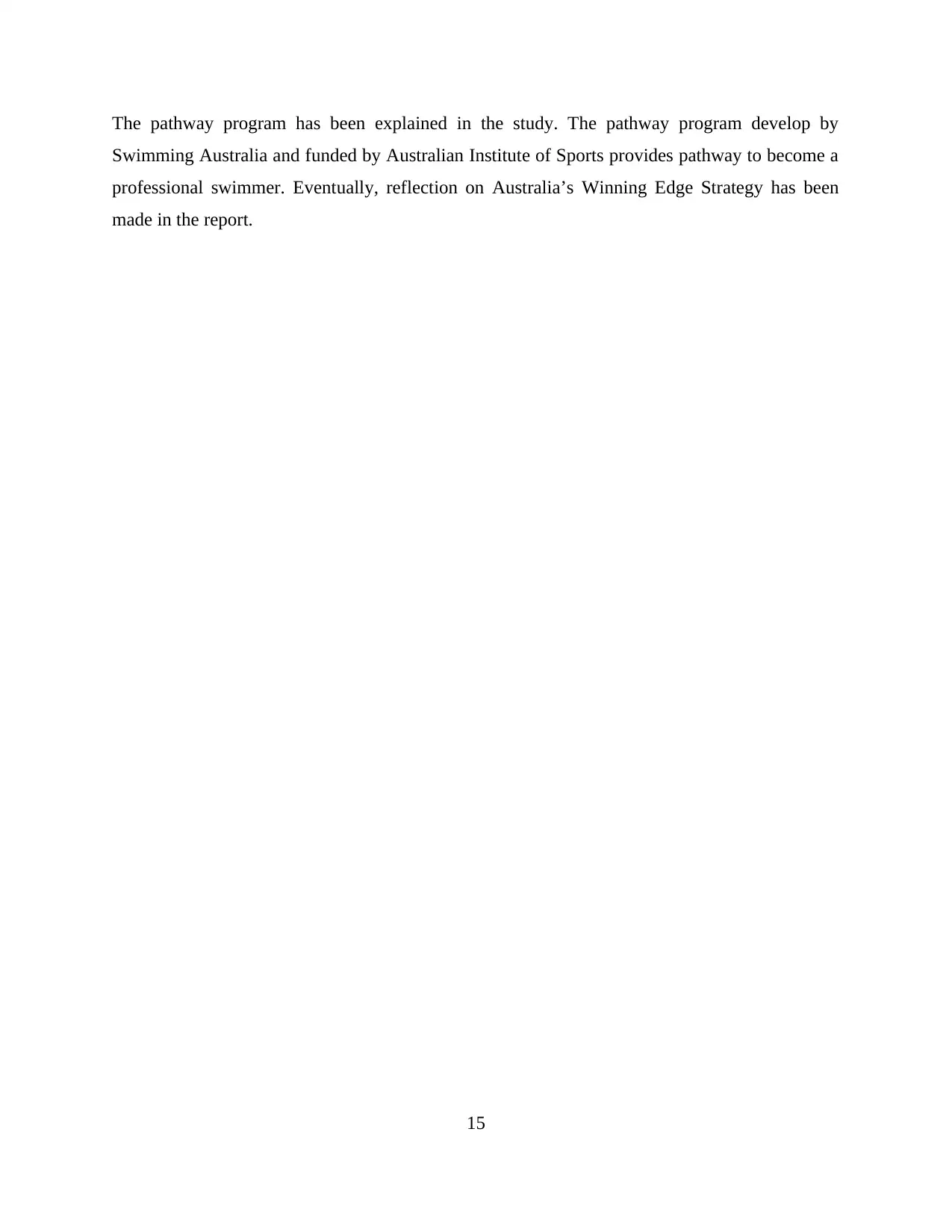
The pathway program has been explained in the study. The pathway program develop by
Swimming Australia and funded by Australian Institute of Sports provides pathway to become a
professional swimmer. Eventually, reflection on Australia’s Winning Edge Strategy has been
made in the report.
15
Swimming Australia and funded by Australian Institute of Sports provides pathway to become a
professional swimmer. Eventually, reflection on Australia’s Winning Edge Strategy has been
made in the report.
15
You're viewing a preview
Unlock full access by subscribing today!

REFERENCES
Books and Journals
Brockett, C., 2017. Australia: Evolution and Motivators of National Sport Policy. In Sport Policy
Systems and Sport Federations (pp. 19-40). Palgrave Macmillan, London.
Desbrow, B., and et.al., 2014. Sports Dietitians Australia position statement: sports nutrition for
the adolescent athlete. International journal of sport nutrition and exercise
metabolism, 24(5), pp.570-584.
Duhig, S., and et.al., 2016. Effect of high-speed running on hamstring strain injury risk. Br J
Sports Med, pp.bjsports-2015.
Gabbett, T.J., and et.al., 2016. High training workloads alone do not cause sports injuries: how
you get there is the real issue.
Gabbett, T.J., and et.al., 2017. Seven tips for developing and maintaining a high performance
sports medicine team.
Hamlin, M.J., Lizamore, C.A. and Hopkins, W.G., 2018. Correction to: The Effect of Natural or
Simulated Altitude Training on High-Intensity Intermittent Running Performance in Team-
Sport Athletes: A Meta-Analysis. Sports Medicine, 48(5), pp.1289-1291.
Mallett, C.J., Rynne, S.B. and Billett, S., 2016. Valued learning experiences of early career and
experienced high-performance coaches. Physical Education and Sport Pedagogy, 21(1),
pp.89-104.
Millett, E., and et.al., 2015. Relationship of leg and joint stiffness during basic and sports
specific tasks in high level athletes.
Murphy, A.P., and et.al., 2015. The relationship of training load to physical-capacity changes
during international tours in high-performance junior tennis players. International journal
of sports physiology and performance, 10(2), pp.253-260.
Schilsky, R.L., 2015. Highlights from the 2015 WIN Symposium: novel targets, innovative
agents, and advanced technologies—a WINning strategy?. ecancermedicalscience, 9.
Thorp, E.O., 2016. Beat the dealer: A winning strategy for the game of twenty-one. Vintage.
Online
AIS high performance funding of sport. 2018 [Online]. Available through:
https://www.ausport.gov.au/__data/assets/pdf_file/0006/650850/AIS_funding.pdf
16
Books and Journals
Brockett, C., 2017. Australia: Evolution and Motivators of National Sport Policy. In Sport Policy
Systems and Sport Federations (pp. 19-40). Palgrave Macmillan, London.
Desbrow, B., and et.al., 2014. Sports Dietitians Australia position statement: sports nutrition for
the adolescent athlete. International journal of sport nutrition and exercise
metabolism, 24(5), pp.570-584.
Duhig, S., and et.al., 2016. Effect of high-speed running on hamstring strain injury risk. Br J
Sports Med, pp.bjsports-2015.
Gabbett, T.J., and et.al., 2016. High training workloads alone do not cause sports injuries: how
you get there is the real issue.
Gabbett, T.J., and et.al., 2017. Seven tips for developing and maintaining a high performance
sports medicine team.
Hamlin, M.J., Lizamore, C.A. and Hopkins, W.G., 2018. Correction to: The Effect of Natural or
Simulated Altitude Training on High-Intensity Intermittent Running Performance in Team-
Sport Athletes: A Meta-Analysis. Sports Medicine, 48(5), pp.1289-1291.
Mallett, C.J., Rynne, S.B. and Billett, S., 2016. Valued learning experiences of early career and
experienced high-performance coaches. Physical Education and Sport Pedagogy, 21(1),
pp.89-104.
Millett, E., and et.al., 2015. Relationship of leg and joint stiffness during basic and sports
specific tasks in high level athletes.
Murphy, A.P., and et.al., 2015. The relationship of training load to physical-capacity changes
during international tours in high-performance junior tennis players. International journal
of sports physiology and performance, 10(2), pp.253-260.
Schilsky, R.L., 2015. Highlights from the 2015 WIN Symposium: novel targets, innovative
agents, and advanced technologies—a WINning strategy?. ecancermedicalscience, 9.
Thorp, E.O., 2016. Beat the dealer: A winning strategy for the game of twenty-one. Vintage.
Online
AIS high performance funding of sport. 2018 [Online]. Available through:
https://www.ausport.gov.au/__data/assets/pdf_file/0006/650850/AIS_funding.pdf
16
1 out of 16
Your All-in-One AI-Powered Toolkit for Academic Success.
+13062052269
info@desklib.com
Available 24*7 on WhatsApp / Email
![[object Object]](/_next/static/media/star-bottom.7253800d.svg)
Unlock your academic potential
© 2024 | Zucol Services PVT LTD | All rights reserved.


